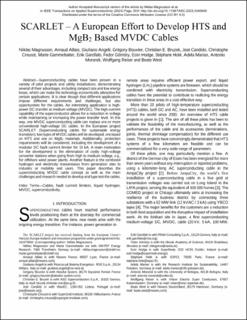| dc.contributor.author | Magnusson, Niklas | |
| dc.contributor.author | Allais, Arnaud | |
| dc.contributor.author | Angeli, Giuliano | |
| dc.contributor.author | Bouvier, Gregory | |
| dc.contributor.author | Bruzek, Christian-Eric | |
| dc.contributor.author | Candido, José | |
| dc.contributor.author | Creusot, Christophe | |
| dc.contributor.author | Gammelsæter, Marte | |
| dc.contributor.author | Garofalo, Erik | |
| dc.contributor.author | Gomory, Fedor | |
| dc.contributor.author | Hodge, Eoin | |
| dc.contributor.author | Hole, Stephane | |
| dc.contributor.author | Marian, Adela | |
| dc.contributor.author | Morandi, Antonio | |
| dc.contributor.author | Reiser, Wolfgang | |
| dc.contributor.author | West, Beate | |
| dc.date.accessioned | 2023-12-12T10:11:55Z | |
| dc.date.available | 2023-12-12T10:11:55Z | |
| dc.date.created | 2023-12-11T14:20:38Z | |
| dc.date.issued | 2023 | |
| dc.identifier.issn | 1051-8223 | |
| dc.identifier.uri | https://hdl.handle.net/11250/3107054 | |
| dc.description.abstract | Superconducting cables have been proven in a variety of pilot projects and utility installations, demonstrating several of their advantages, including compact size and low energy losses, which can make the technology economically attractive for certain applications. It is clear though that different applications impose different requirements and challenges, but also opportunities for the cables. An interesting application is high-power DC transfer at medium voltage (MVDC). The high-current capability of the superconductor allows for a reduction in voltage while maintaining or increasing the power transfer level. In this way, one MVDC superconducting cable can replace one or more conventional high-voltage DC cables. In the European project SCARLET (Superconducting cables for sustainable energy transition), two types of MVDC cables will be developed, one based on HTS and one on MgB2 materials. Additionally, protection requirements will be considered, including the development of a modular DC fault current limiter for 10 kA. A main motivation for the development is the elimination of costly high-voltage converter stations when going from high to medium voltage, e.g., for offshore wind power plants. Another feature is the combined hydrogen and electricity transmission from generation sites to industry or mobility end users. This paper describes the superconducting MVDC cable concept as well as the main challenges and research needed to develop and type test the cables. | en_US |
| dc.description.abstract | SCARLET – A European Effort to Develop HTS and MgB2 Based MVDC Cables | en_US |
| dc.language.iso | eng | en_US |
| dc.publisher | IEEE | en_US |
| dc.rights | Navngivelse 4.0 Internasjonal | * |
| dc.rights.uri | http://creativecommons.org/licenses/by/4.0/deed.no | * |
| dc.title | SCARLET – A European Effort to Develop HTS and MgB2 Based MVDC Cables | en_US |
| dc.title.alternative | SCARLET – A European Effort to Develop HTS and MgB2 Based MVDC Cables | en_US |
| dc.type | Peer reviewed | en_US |
| dc.type | Journal article | en_US |
| dc.description.version | acceptedVersion | en_US |
| dc.rights.holder | The Authors hold the copyright to the Author Accepted Manuscript. Distributed under the terms of the Creative Commons Attribution License (CC BY 4.0) | en_US |
| dc.source.journal | IEEE Transactions on Applied Superconductivity (TAS) | en_US |
| dc.identifier.doi | 10.1109/TASC.2023.3340646 | |
| dc.identifier.cristin | 2211837 | |
| dc.relation.project | EU – Horisont Europa (EC/HEU): 101075602 | en_US |
| cristin.ispublished | true | |
| cristin.fulltext | postprint | |
| cristin.qualitycode | 1 | |

